Solar Air Conditioner
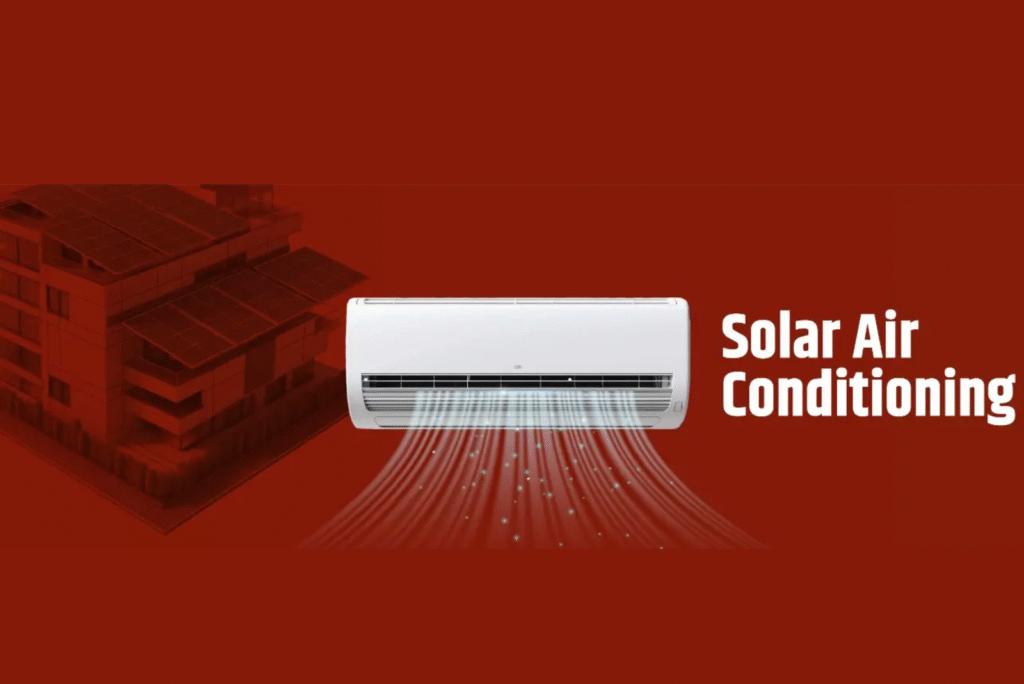
Solar Air Conditioner Home Blogs Popular Posts All Posts Blog Seasonal Maintenance Tips for Solar… October 6, 2025 Solar Water Pump vs Regular… October 6, 2025 Rooftop Solar vs Ground-Mounted Solar October 6, 2025 Choosing the Best Solar Panel… October 6, 2025 Power Your Future with KLK Ventures Pvt. Ltd. Delivering reliable solar solutions for a sustainable tomorrow. Switch to clean energy and save with us today. Contact US With summer arriving, temperatures soar across India, and staying cool becomes really important. Air conditioners are what help during such hot days. However, as the heat increases, so do the bills. That’s where solar for air conditioning enters the picture. A great solution that is not only comfortable and relieving but also cost-effective. Solar air conditioning is also something you should consider when searching for eco-friendly options. In this blog, we’ll learn what makes solar for air conditioning an amazing option. What is a Solar Air Conditioner? A solar air conditioner uses solar energy to cool your home or office spaces. The best part of the solar air conditioner is the energy independence it offers. This cool and innovative system doesn’t rely on the electricity grid to operate, thus saving on bills. It’s just like your regular air conditioners but much more efficient and beneficial in all aspects. The best thing you’re doing by choosing solar for air conditioning is keeping aside all the non-renewable energy sources for power needs. You’ll be able to enjoy cool and fresh air without any worries. How Does a Solar Air Conditioner Work? Are you wondering how these amazing solar air conditioners work? Read on! 1. Solar Panels Capture SunlightThis is how it all starts, with the most important part — solar panels. We’re sure you’re already aware of how solar panels work. These panels that are mounted on an open space or roof catch the sun’s rays and convert them into direct current (DC) electricity. 2. Power is Directed to the Air ConditionerNow that solar panels have generated electricity, it is sent to your solar air conditioner. However, it depends on the type of system you have. DC solar air conditioners run directly on the DC electricity from the panels. There’s no need for you to convert it.Hybrid solar ACS use solar power where there’s availability. If there’s no solar power, it continues using grid electricity.Grid-tied systems, after using the electricity, send any excess amount back to the grid for later use. This earns you credits too! It doesn’t matter what system you have, the point is that air conditioning with solar power will reduce your bills. 3. Optional Battery StorageSome of the solar air conditioning systems come with solar energy storage. This means the battery storage collects the energy during the day and keeps it for use at night or on cloudy days. You get uninterrupted cooling! This is useful for places that require full-time air conditioning with solar power. 4. Cools Your SpaceWhen the solar generated electricity powers the solar air conditioner, just like a regular AC, you get some cool and fresh air. The waves of air throughout the room will cool your space and offer comfort. Benefits are low electricity costs with the same efficiency! Isn’t solar for air conditioning amazing? Types of Solar Air Conditioning Systems There are many solar air conditioners, and each of the air conditioning with solar power works differently. Let’s see if solar for air conditioning fits well for your needs. Hybrid Solar Air Conditioners In countries like India, hybrid solar air conditioners are getting popular. These systems use both solar energy and electricity from the grid. However, their dependency on the grid is only when there’s no solar energy available. These systems are amazing for homes that want to use solar for air conditioning without fully letting go of the grid electricity. Hybrid solar air conditioners are very low maintenance, along with being cost-effective. DC Solar Air ConditionersMostly, solar air conditioners run on direct current, and that is why DC powered solar air conditioning systems are popular. These systems are run entirely on solar power and are not tied to the grid. They’ll turn out to be one of the most environmentally friendly choices for solar air conditioning. Grid-Tied Solar Air ConditionersThis system is somewhat similar to hybrid ACS but with the benefits of net metering. The solar air conditioners use solar energy during the day and if there’s excess energy, it’s sent back to the grid. You earn credits, thus reducing your electricity bills. Make the most of your solar for air conditioning by choosing these systems. Solar Thermal Air ConditionersNow, there are some air conditioners that use heat instead of electricity. These are slightly complex and you can often find them in commercial buildings. The sun collectors gather heat energy and it powers absorption chillers. The same chillers cool water and this is circulated to cool the air. These are an innovative form of solar air conditioning. Air conditioning with solar power offers a unique approach to air conditioning with solar power. Cost of Air Conditioning with Solar Power in India Here’s the general price list: Solar AC Panel Power of the Panel Selling Price 1 Ton Solar Air Conditioner 1500 Watt ₹90,000-1,00,000 1.5 Ton Solar Air Conditioner 2500 Watt ₹1,00,000-1,40,000 Government Subsidies for Solar Air Conditioners The government offers good subsidies for the installation of solar panels across India. If you’re wanting to install solar panels at your home or business site, you’ll be eligible to apply for a subsidy. There’s, however, no particular subsidy for the air conditioners. However, connecting your air conditioners to the solar panels will benefit you a lot. 1 kWh- 3 kWh systems get a subsidy up to 40%, and 4 kWh- 10 kWh systems get a subsidy up to 20 %. Read more about government subsidies here – solar panel subsidy in India & 1 kWh solar panel in India. Benefits of Solar for Air Conditioning There are so many advantages of solar panel installation. And the
1kW Solar Panels in India
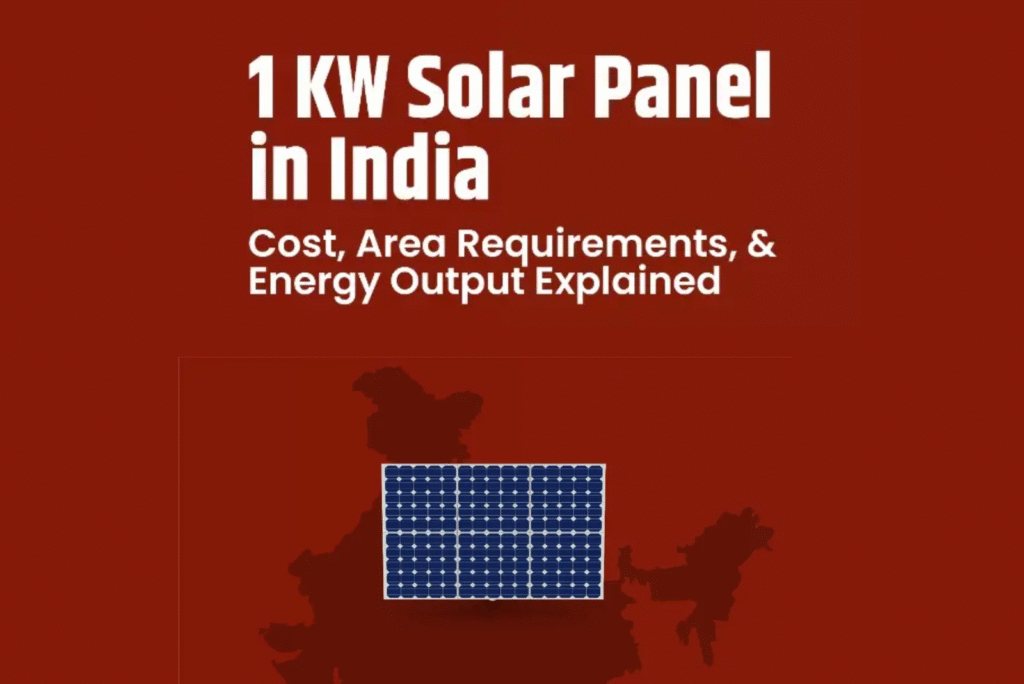
Everything About 1kW Solar Panels in India: Cost, Area & Energy Output Home Blogs Popular Posts All Posts Blog Seasonal Maintenance Tips for Solar… October 6, 2025 Solar Water Pump vs Regular… October 6, 2025 Rooftop Solar vs Ground-Mounted Solar October 6, 2025 Choosing the Best Solar Panel… October 6, 2025 Power Your Future with KLK Ventures Pvt. Ltd. Delivering reliable solar solutions for a sustainable tomorrow. Switch to clean energy and save with us today. Contact US As solar energy becomes accessible across India, many homeowners and small businesses are eager to explore solar power as an eco-friendly solution. Solar power systems are a very cost-effective method of harnessing power, which is why many people are looking into the price for a solar panel in India to get a clear idea of all the costs. In this blog, you’ll learn about the price of 1 kW solar panel, space requirements, and energy outputs. Let us know if a 1 kw solar panel system fits well for your energy goals! How Much Does a 1 KW Solar Panel System Cost in India? We know understanding the price of 1 KW solar panel systems in India is the first step to look into. Whether it’s for a small home installation or a business, knowing the price for a solar panel will help you. 1 KW solar panel price in India varies widely, as it all depends on many factors. Some of them are panel type, brand, installation, inverter, and also on the type of solar power system. However, to give you a fair idea about the price of 1 KW solar panel, let’s break down the costs. These costs are based on panel type and system configuration. Polycrystalline panels: ₹45,000 to ₹55,000 Monocrystalline panels: ₹55,000 to ₹70,000 With installation and inverter: ₹60,000 to ₹85,000 Polycrystalline solar panels are generally more budget-friendly, while monocrystalline panels offer higher efficiency. You can choose any one of the polycrystalline and monocrystalline panels for your home or business. It’s not difficult to install a solar panel system on your own, and noting the lower price for a solar panel setup, many people consider the same. However, for the best energy output, choosing a full-service installation is preferable. What Affects the Price for a Solar Panel? 1 KW solar panel price depends on a lot of factors that are mentioned above. Let’s go through them in detail. Panel Efficiency – Solar panels like monocrystalline are usually very efficient and tend to fall on the costly side. Installation Type – The price of 1 KW solar panel also depends on the installation type (on the roof or on the ground). Inverter Selection – The inverter also plays a vital role in deciding the price of 1 KW solar panel. An on-grid solar system inverter requires an inverter that is less costly than the hybrid or off-grid ones. Brand and Warranty – You already know that different brands have different prices for solar panels. Brands that are reputed come with a higher price tag but give off amazing energy output. Subsidies and Incentives – The Indian government offers various subsidies for the installation of solar panels. For instance, the Central Financial Assistance (CFA) offers up to 40% subsidies for installing rooftop solar systems up to 3 kW. Also Read – Solar panel subsidy in India and 2 kW solar panel price with subsidy to learn more in-depth about the same. How Much Space Do You Need to Install a 1 KW Solar Panel? Space for solar panel installation is something you need to consider importantly along with the price of 1 kw solar panel. A 1 KW solar panel system generally requires around 80 to 100 square feet of maximum sunlight space. However, it’s important that you know the size and efficiency of panels affect the area that is required. Space for solar panel installation is something you need to consider importantly along with the price of 1 kw solar panel. A 1 KW solar panel system generally requires around 80 to 100 square feet of maximum sunlight space. However, it’s important that you know the size and efficiency of panels affect the area that is required. Roof type and OrientationFlat Roofs – You can easily mount your 1 kW solar panel systems on flat roofs. Orientation is important to make the maximum use of solar energy. The panels should face south to capture maximum sunlight. Sloped Roofs – A tilt angle between 15-30 degrees works best for solar roofs. Panel EfficiencyHigher panel efficiency means that you need very little space for the maximum energy output. Panels like monocrystalline panels with efficiency up to 25% take up 10-20% less space than polycrystalline panels. If there’s a limited space, you can opt for PERC panels that offer amazing energy output. Benefits of a 1 kW Solar Panel System Payback Period – The initial price for a solar panel generally ranges between ₹ 50,000 to ₹80,000. And you’ll be saving on your electricity bills, which are generally ₹1500-2000 monthly. This means the payback period is typically 4 to 5 years! Long-term Benefits – Your electricity generation is basically free after the payback period. You’ll no longer need to be dependent on the grid for power all the time. Eco-friendly – Along with the low 1 kW solar panel price, you’re getting an environmentally friendly alternative. You’re not just saving money but also helping the environment. Property Value Boost – By installing a solar panel system on your property, you’re increasing its value. The potential buyers will be attracted to your building or house due to the solar power systems. Government Incentives – Installing solar panels has become very easy and affordable because of the many subsidies the government offers. Even State-Level governments are contributing to the encouragement of solar power systems. This lowers the 1 kW solar panel price in India further. Quick Installation – Because of the compact size, installing a 1 kW solar panel is very simple. It consumes less time and offers
What are Greenhouse Gases?

What are Greenhouse Gases? Home Blogs Popular Posts All Posts Blog Seasonal Maintenance Tips for Solar… October 6, 2025 Solar Water Pump vs Regular… October 6, 2025 Rooftop Solar vs Ground-Mounted Solar October 6, 2025 Choosing the Best Solar Panel… October 6, 2025 Power Your Future with KLK Ventures Pvt. Ltd. Delivering reliable solar solutions for a sustainable tomorrow. Switch to clean energy and save with us today. Contact US Climate change is a looming crisis intensified by greenhouse gases. These gases exist naturally in the atmosphere and are actually significant to sustain life. However, with the constant human activities, these are rising at an alarming rate, causing a problem. In this blog, we’ll take a closer look at how GHG greenhouse gases impact the environment. And also explore one of the best solutions out there, solar energy. Greenhouse Gases and the Greenhouse Effect The greenhouse effect is a natural process that keeps the Earth warm and livable. There won’t be any life without it, as the planet will be too cold to support any life. Let’s see how the process works in detail: 1. Sunlight AbsorptionThis is the start of the whole process. Sun’s rays reach our planet and illuminate it. Our Earth absorbs this energy obtained from the sun and generates a suitable environment. You can probably guess that it is this warmth that makes the sustenance of life possible. 2. Heat RadiationOnce the Earth absorbs the sunlight, the remaining heat is sent back towards space. 3. Greenhouse Gases Trap HeatHowever, some of the radiated heat doesn’t escape into space as the greenhouse gases in the atmosphere trap it. This heat causes further warming. 4. Normal BalanceUnder normal conditions, the greenhouse effect is not something to worry about. However, the continuing concentration of GHG greenhouse gases is a cause of worry for all of us. This is causing a major problem for the environment known as global warming. This, in turn, causes a lot of disruption to the weather patterns and leads to negative environmental consequences. What Are the Main Greenhouse Gases? 1. Carbon Dioxide (CO2)Carbon Dioxide (CO2) is by far the biggest contributor to climate change. When we humans burn fossil fuels like coal, oil, or natural gas for energy, there’s a huge production of these gases. There’s another thing that adds to the increase in CO2 levels. It’s deforestation. You might already know that trees absorb carbon dioxide from the atmosphere, helping balance it all out. But by cutting the trees down, there will be very little CO2 absorption. 2. Methane (CH4)While Methane makes up a smaller portion of greenhouse gases, it’s more effective at trapping heat than CO2! These gases are released when agricultural practices take place, especially livestock digestion, and also from landfills or natural gas production. 3. Nitrous Oxide (N2O)Nitrous oxide is probably familiar to you from its use in agricultural pesticides and fertilizers. Additionally, some industrial processes produce this greenhouse gas. What makes this one harmful, if you were wondering, is that it lingers in the atmosphere for a very long time. 4. Fluorinated GasesThese are another set of gases that are synthetic and contribute to the greenhouse effect. Similar to the case of N2O, these gases persist in our atmosphere for many, many years. We are sure you must have guessed how this property makes them super threatening to our climate. Why Are Greenhouse Gases Harmful?●Global Warming – As the levels of greenhouse gas rise, global temperatures spike up. The glaciers and polar ice caps melt leading to high sea levels. ●Extreme Weather – The imbalance of greenhouse gases impacts the environment negatively. These gases lead to severe weather conditions. Storms, droughts and frequent heat waves cause unfavourable weather conditions. ●Threat to Ecosystems – The increasing greenhouse gases disrupt the ecosystem to a great extent. It becomes difficult for the animals, birds and other species to survive with the increasing change in the climate. ● Human Health Risks – Apart from environmental issues, this rapid change in temperature worsens air pollution, leading to respiratory problems. The change can also increase the speed of various diseases which prove to be harmful to humans. How Can We Reduce Greenhouse Gases? The problem is increasing day by day, but there is still hope for improvement in today’s situation. This slow and steady change will come by inculcating renewable energy sources. 1. Switch to Solar PowerWe all use large amounts of energy on a daily basis. Imagine what our world as a whole consumes. Most of this energy is from fossil fuels which cause greenhouse gas emissions. This CO2 emission can be reduced if we decide to switch to solar power. Solar energy results in zero emissions while being adaptive to your homes, offices, corporations and even large scale industrial plants. 2. Solar-Powered Homes and Buildings Rooftop solar panels merged with technologies like outdoor solar lighting not only protect the environment but also your monthly electricity bills. It’s a one-time investment that pays off really well in all aspects. There are so many government schemes and subsidies that will make even this one-time investment super affordable for you. You can also use solar cookers, solar water heaters and much more. 3. Solar Powered Transportation A large number of fossil fuels are burned for driving vehicles. Travel and transport need a lot of energy and also release lots of polluting greenhouse gases. In these cases, solar powered vehicles (EVs) can be the best choice. Instead of the prevalent gas-powered cars, they are more eco-friendly and reliable. Setting up solar charging stations will also be a nice step to motivate opting for solar solutions instead of fossil fuels. 4. Commercial Solar Solution Our commerce sector is among the largest consumers of fossil fuels, which contributes to increasing pollution. Slowly, many companies are going solar by choosing commercial solar systems. Not only does this play a part towards our ecosystem, but it also proves beneficial in the long run. 5. Solar Farms and Large-scale ProjectsIndustries would be
Solar Panel Installation: A Step-by-Step Guide
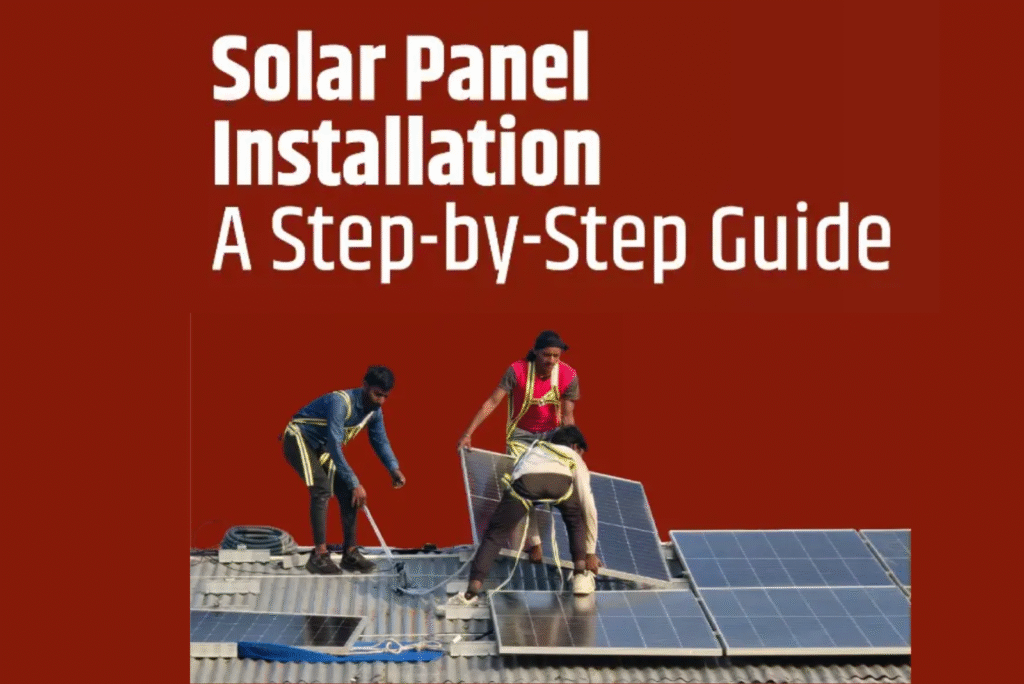
Solar Panel Installation: A Step-by-Step Guide Home Blogs Popular Posts All Posts Blog Solar Panel Installation: A Step-by-Step… October 4, 2025 2 kW Solar Panel Price… October 4, 2025 Solar Inroof System: Using Solar… October 4, 2025 What is an On-Grid Solar… October 4, 2025 Power Your Future with KLK Ventures Pvt. Ltd. Delivering reliable solar solutions for a sustainable tomorrow. Switch to clean energy and save with us today. Contact US The installation of solar panel systems is popular today as people are embracing renewables as a result of rising energy costs and eco-friendly concerns. This makes solar power one of the most readily available options as it is technology-friendly and government-supportive policy friendly. The installation of solar panels will lead to clean eco-friendly power generation and is beneficial to the environment. Long term investments show promise to generate savings while at the same time contributing to a cleaner environment. The all-in-one strategy proprietary approach provided on this platform allows for ease of understanding in each section of installation. Hence the provided pivot diagram guide is adequate for all-seven stages, starting from the initial survey powering households with eco-friendly energy to solar panel installation. Check our Step by step guide in the succeeding chapters that aim at powering your home with clean different types of solar energy. Step-by-Step Solar Panel Installation Process A complete guide to each stage of installing a solar power system: Step 1 – Site Survey We kick off the steps needed to prepare your site with a comprehensive site survey. This step can only be carried out by a qualified technician whose job is to ensure that solar panels can be installed onto your home or building. Specifically, making sure that the space in question has unobstructed sunlight as well as the structural integrity to house the solar panels. As a rule of thumb, site surveys cover the following steps: Looking at the roof’s structure including the tilt and the direction it faces Investigating prospective shadiness from pillars, nearby buildings or trees Evaluating the amount of space that is accessible for the panels, wiring, inverter, and even the switch Examining the electric load and the existing connection points If you are searching for resources that would help you understand how solar panels work, we invite you to read our blog on the mechanics of solar panels. Step 2 – System Design and Engineering After the site has been approved, we move forward to System Design and Engineering. This particular step includes the design of a solar solution that is tailored specifically to meet energy requirements as far as the property conditions are considered. Components that are key and were decided upon in this primary step include but are not limited to: Estimations of solar panels needed based on average daily usage Selection of the type of the panel from either monocrystalline or polycrystalline. Specifics of the solar inverter to use which may be string, micro or hybrid Wiring layout and safety devices Step 3 – Permits and Documents Before starting any work, solar systems need to be vetted by the local utility company and the government. Most solar providers offer assistance with the important documentation needed. Some of the documentation needed includes: Application for net metering with DISCOMs Electrical safety endorsement from a qualified person Permission for installation from either municipality or society Application for state/central solar subsidies (if they are being provided) Completing this process may take several days or even weeks based on local requirements, although this is important for linking your system to the grid in a legal manner. Step 4 – Purchasing Equipment Now, the installer starts purchasing the equipment. This step includes acquiring all components required for the installation of the solar panels. The following components are foundational: Solar panels (with 25-year warranty, the better option is MNRE-approved Tier 1 panels) Inverter (depending on system type; grid tied, hybrid, off-grid) Mounting structures (commonly galvanized iron or aluminum) Cables and MC4 connectors (weatherproof and UV resistant) Backup batteries (optional) Step 5 – Installation of Solar Panels The first step is to prepare the roof and mount the solar panel structure before securing it on. Steps involved in solar panel installation: Attaching the mounting framework to the roof surface Tiling and positioning the panels within the appropriate angle of inclination Safeguarding the panel against solar winds and other weather conditions Arranging the panels in a way that minimizes shading effects between rows Step 6 – Electrical Wiring The next step is wiring, where the panels are connected to the inverter and integrated with the power system. Connecting the panels in series or parallel as per the system’s design Running DC cables from the solar panels to the inverter Adding isolators, surge protection, and junction boxes Maintaining adequate earthing and grounding so as to eliminate electrical hazards Proper wiring with reliable fasteners is the cornerstone of the system’s performance reliability and overall durability. Step 7 – Connecting to Inverter The inverter is important as it enables utilization of solar energy by changing it into electricity. The inverter converts the direct current (DC) produced from the panels into alternating current (AC) to be used by appliances in the home. Process of Connecting an Inverter Includes: Connecting the DC Cables from the Solar Panels to the Inverter Linking the Inverter’s AC Output to the Home’s Main Power Supply Setting Up Monitoring Systems (mobile application/web-based) If it is a hybrid system, connecting the battery and the grid. The inverter device provides data in real-time about the generation of solar energy, the savings made, and the health of the system. Step 8 – Net Metering Connection to the grid is essential for net metering setup where maximum savings must be achieved. This gives the ability to sell excess electricity to the grid and receive credits. How the net metering works: The meter shows the energy consumed as well as the energy forwarded to the grid. Some states pay for the surplus units provided to the grid. This
2 kW Solar Panel Price in India with Subsidy
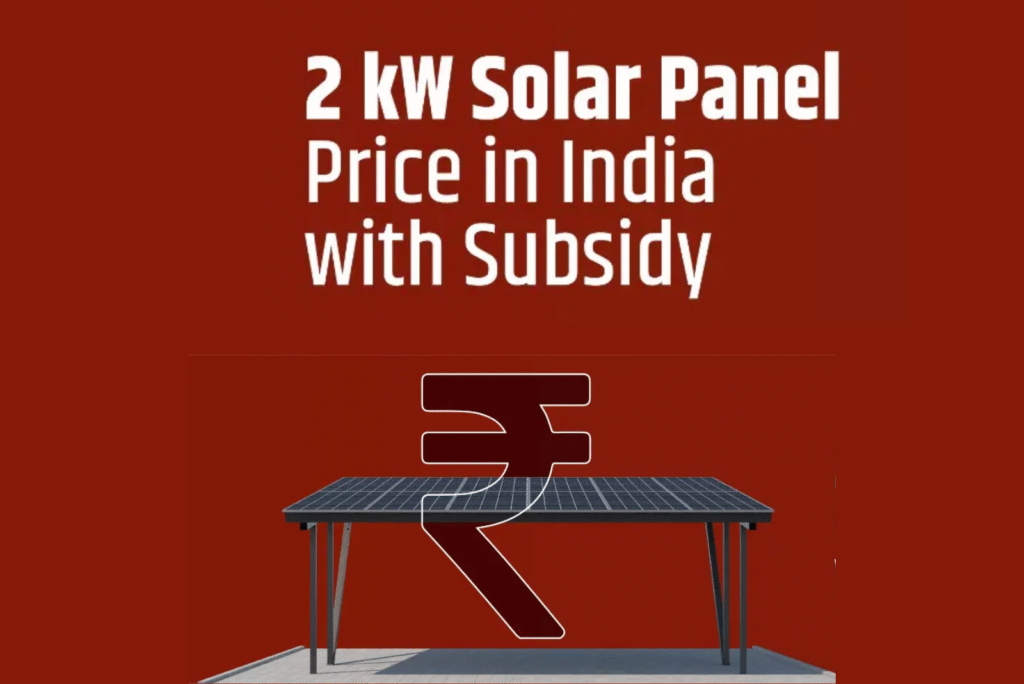
2 kW Solar Panel Price in India with Subsidy Home Blogs Popular Posts All Posts Blog 2 kW Solar Panel Price… October 4, 2025 Solar Inroof System: Using Solar… October 4, 2025 What is an On-Grid Solar… October 4, 2025 What Is an Off-Grid Solar… October 4, 2025 Power Your Future with KLK Ventures Pvt. Ltd. Delivering reliable solar solutions for a sustainable tomorrow. Switch to clean energy and save with us today. Contact US In a world where clean energy is becoming a priority for many, people are looking for practical ways to reduce their carbon footprints. Solar energy emerges as a sustainable solution. The 2 Kilowatt solar system can be a great starting point if you’re wanting to switch to solar energy. Before you start, we know how important it is to know the 2 kW solar panel price, solar panel subsidies, and other aspects. In this blog, we’ll guide you through all that you need to know before bringing home the wonderful solar power systems. Solar Panel Price in India There are a lot of factors that affect the solar panel 2 kW price in India. These are brands, quality, and other requirements. However, to give you a rough idea, a 2 kW solar system generally costs between ₹1,50,000 to ₹1,70,000. The general prices of solar panels in India are: Solar Panel System Capacity Solar Panel Price 1 kW ₹80,000 – ₹85,000 2 kW ₹1,50,000 – ₹1,70,000 3 kW ₹2,50,000 – ₹2,70,000 5 kW ₹3,10,000 – ₹3,50,000 Understanding 2 Kilowatt Solar Panels A 2 kW solar system is a great choice for houses. Because of its amazing efficiency and cost-saving nature, it’s the most preferred option. Depending on brand and panel efficiency, a 2 kW solar panel system generally has 5 to 6 panels. The 2 kW solar system is made to be efficient and compact. This makes it perfect for homes that have limited roof space and moderate energy consumption. And you know the best part is the affordability, a 2 kW solar panel price is budget-friendly and a good investment. Space Requirements for Your 2 Kilowatt Solar Panel System The first thing to consider is the space for the installation of a 2 kW solar panel system. Space is important because the location and surrounding factors will determine the working of the panels. The roof or any open area is the best because these are the areas that get constant sunlight throughout the day. For a system of up to 2 kW, 160 to 200 square feet of space is sufficient. However, there’s one thing you need to be sure of. Installing the panels at the right angle. Better absorption of sunlight will lead to better energy output. What Affects the 2 kW Solar Panel Price in India? There are many factors that affect the 2 kW solar panel price, including – Brand and Quality – The solar panel 2 kW price in India mostly depends on the brand and quality of the solar system. Solar panels from the most reputable brand may cost a bit more but they tend to offer higher efficiency and better performance. The quality is also top-notch. So while selecting solar panels for your homes, do focus on the brand and quality. Solar Panel Plate Rate – The total cost depends on the solar plate rate. Panels that have newer technology are more costly than older technologies. An individual solar plate further determines the total value of the system. You’ve to choose from the best panels if you want your solar power system to work efficiently. Installation Costs – The installation price of 2 kW solar panels varies a lot too. The complexity of the installation and location greatly impact the costs. Some places and installations require a lot of effort and time leading to higher installation fees. Government Subsidies – The government subsidies have a huge effect on the 2 kW solar panel cost as well. The subsidies and incentives have a huge impact on bringing down the installation costs, which makes them within the budget and affordability of middle-class families. 2kW Solar Panel Price with Subsidy Solar panel subsidies in India are what make the installation of on-grid solar systems and off-grid solar systems affordable and possible. A 2 kW solar panel price in India is usually around ₹1.5 to 1.7 lakh. However, with the government’s incentives and rebates, the solar panel 2 kW price in India has come down by 30-40% depending on the state. Central Government Subsidy for Solar Systems ● The PM Surya Ghar: Muft Bijli Yojana generously offers subsidies for rooftop solar installations. For systems up to 2kW, you can get a subsidy of up to 60%. ● The Grid Connected Rooftop Solar Programme under the Ministry of New and Renewable Energy (MNRE) targets the installation of solar panels. The best part is that it offers Central Financial Assistance (CFA) that covers 40% of the costs for systems up to 3 kW. State-Level Subsidies At the state level, the governments are coming up with various schemes to promote the use of solar energy. States such as Rajasthan, Uttar Pradesh, Tamil Nadu, Maharashtra, and Punjab offer great subsidies for the installation of solar panels. Benefits of Installing a 2 kW Solar Panel System 1. Cost Savings A 2 kW solar panel price is not only affordable during the installation process but also cost-effective in the long run. You’ll be generating your own electricity. You know what that means? No sky-high electricity bills! The photovoltaic panels create power that is not only clean but also wallet friendly. 2. Environmental Impact You already know that solar energy is good for the environment. There are many benefits of installing rooftop solar panels. Not causing harm to the environment is one of them. The electricity that these panels produce is completely clean and green. 3. Energy Independence Along with the affordable 2 kW solar panel price, you get the amazing benefit of energy independence. An off-grid solar system will generate electricity for you and even store it
Solar Inroof System: Using Solar Panels as a Roof
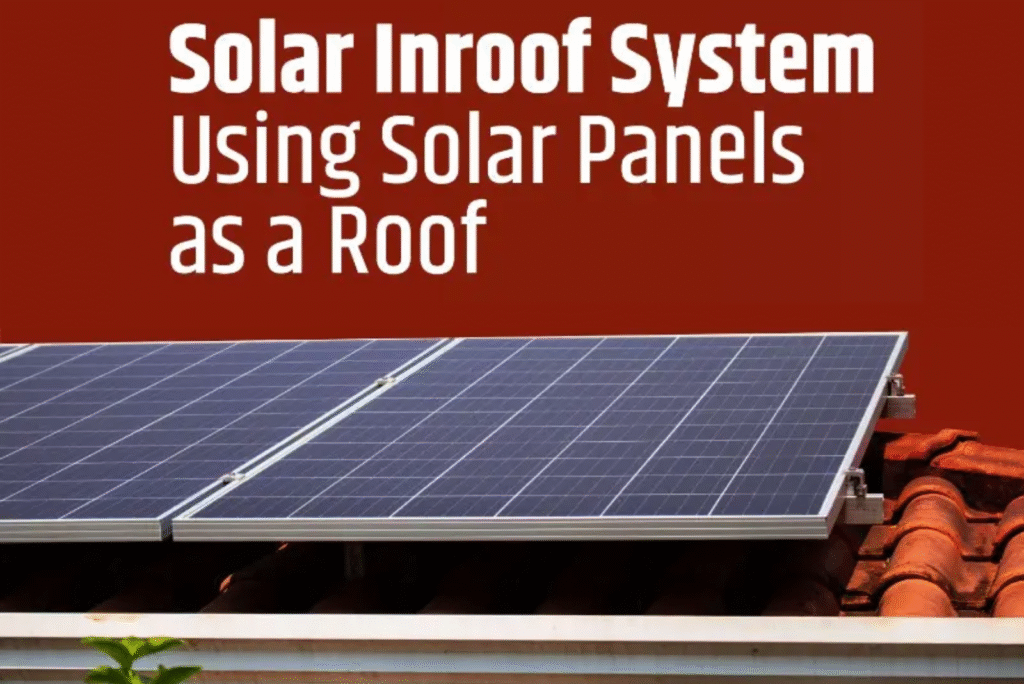
Solar Inroof System: Using Solar Panels as a Roof Home Blogs Popular Posts All Posts Blog Solar Inroof System: Using Solar… October 4, 2025 What is an On-Grid Solar… October 4, 2025 What Is an Off-Grid Solar… October 4, 2025 What are the Main Components… October 4, 2025 Power Your Future with KLK Ventures Pvt. Ltd. Delivering reliable solar solutions for a sustainable tomorrow. Switch to clean energy and save with us today. Contact US The modern world has been revolutionized by the concept of utilizing solar energy, with numerous options available for homes and businesses to take advantage of it. Solar energy not only provides homeowners with the opportunity to save money, but it also allows them to play a role in maintaining the environment. Using solar panels as roofs does not only protect the building, but also helps in the sustainability of the environment. Solar roofing refers to replacing regular roofing materials with solar panels. Unlike traditional systems that mount panels over an existing roof, this approach incorporates solar panels into the structure itself. With this new technology, the aesthetics as well as energy expenditure of the building are maximized making optimized use of the roof space. Benefits of Using Solar Panel as a Roof When a solar panel doubles as a roof, it is a revolution for businesses and homeowners alike. It fosters energy production alongside structural functionality, leading to cost efficiency and sustainability. With the focus on renewable energy sources, this solution is rapidly gaining acceptance globally. 1. Creates Electrical Energy Without Compromising Home Protection A solar roof serves the dual purpose of protecting your home while generating electricity from sunlight. For the energy-sensitive homeowners, this feature alone makes it a worthwhile investment. 2. Improved Solar Energy Generation Commonly homeowners refrain from the idea of installing solar panels on the roof because they tend to look very chunky. With the new blend of solar panels and roofing, panels have a sleek modern appearance that will appeal to many more homeowners. This flexibility makes solar roofs more effective. 3. Maximizes Roof Surface Area Solar panel installation as a roof replaces the conventional roofing concept. In rest-mounted installations, the solar panels eat up a lot of space. Integrated solar roofing uses the entire space without needing any additional equipment, mounting hardware, and other solar panel accessories. If you want to know more about how solar panels work please read this blog – How do solar panels work? 4. Enhances Energy Efficiency In-roof solar panels reap the most sunlight compared to conventional solar panels. In roof solar panels consume a lot of solar energy since they do not have any shading issues coming from conventional roof structures like gables and hips. Unlike in-roof solar panels, standard panels get placed at angles that do not face the sun directly, reducing energy production due to suboptimal exposure. 5. Reduces Costs Over a Long Duration A solar roof is typically seen as more expensive, but in the long term the return is worth it. Having a clean energy generation system lowers the electricity bill significantly and dependency on grid power decreases. Other than that, there are propositioned benefits from various governments making solar roofing a very appealing option. 6. Increases Property Value Real estate agents claim that the home energy rating system associated with solar panels and roofing integrated systems tends to lure energy-smart buyers. This translates to increased resale value in the long term due to the added solar system. 7. Endures Severe Weather Conditions Compared to traditional roofs, solar roofs have a better longevity. Prolonged harsh rains, hail, strong winds, and even snow do not affect the functionality of the panels. The rugged design these panels possess means they withstand the elements without wearing out. In-Roof vs. Traditional Roofing Solar Panels Comparison Feature In – Roof solar panel Traditional solar panel Installation method Integrated into the roof by replacing conventional roofing materials. Installed on top of the existing roof using mounting brackets. Visual effects Sleek, modern look that blends with the architecture. Bulky appearance that may affect the aesthetic of the building. Space efficiency Maximizes roof space without extra hardware. Requires additional space for mounting systems. Cost comparison Higher upfront costs but better long-term savings and value. Lower initial cost but may incur higher maintenance over time. Things To Consider Before Installing A Solar Roof If the roof receives sunlight for a large part of the day, energy generation will be significantly higher. South-facing roofs are ideal, but east and west-facing roofs also yield good results. One of the most important inventions nowadays is solar energy and how it can be utilized. Not only does it help to save money for the homeowners but helps in conserving the environment. It also allows the installation of solar panel roofs which helps in the sustaining of the environment. Budget and Financing Options Even though the initial payment is expensive, there is an array of financing options available. These include solar loans, leasing schemes, and even government subsidies. Such aids make the cost of installing solar panels on roofs more feasible. Energy Requirements Before going ahead with the installation, assess how much electricity you consume in a day. Doing so will enable the determination of how big the solar roof needs to be so that it meets your energy requirements. Conclusion For modernists looking to cut expenses and become more cost-effective, using a solar panel as a roof is and will always remain, ŝ a smart investment. In addition to the myriad of benefits it brings, it’s a compact solution for saving space, visually appealing as well, making it stand out in comparison to traditional solar panels. Financial incentives paired with growing environmental concern will make mountable solar roofs the go-to choice. Switching to solar panels and roofing will help regain control over energy expenditures while paving the way toward a cleaner surrounding. If you wish to embrace renewable energy sources while going green, start by looking at your options today.
What is an On-Grid Solar System?
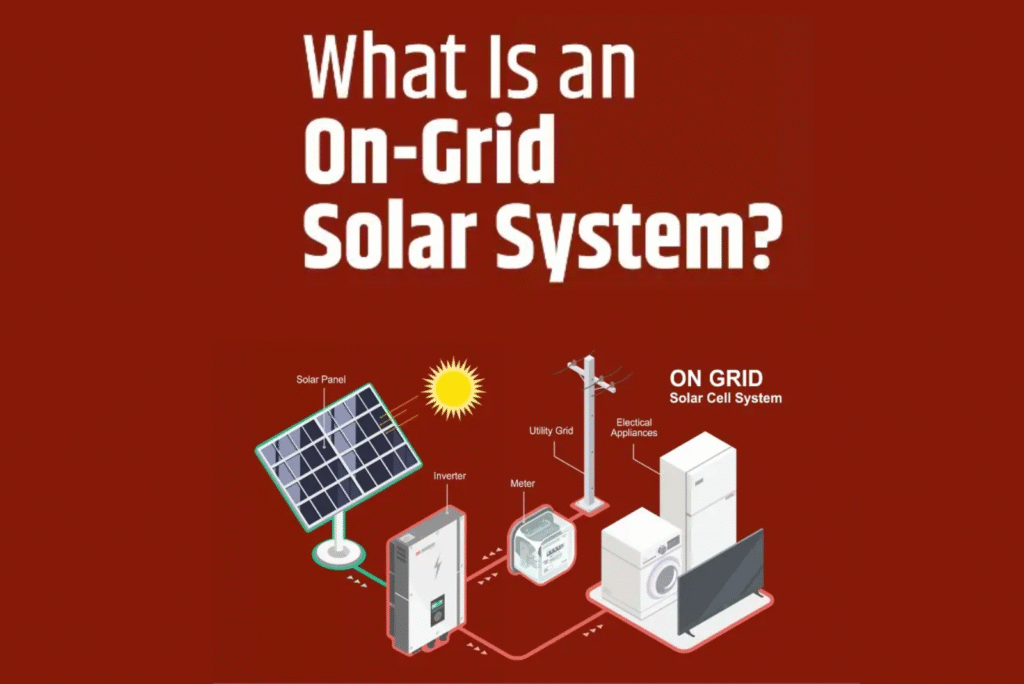
What is an On-Grid Solar System? Home Blogs Popular Posts All Posts Blog What is an On-Grid Solar… October 4, 2025 What Is an Off-Grid Solar… October 4, 2025 What are the Main Components… October 4, 2025 What is a Solar Street… October 3, 2025 Power Your Future with KLK Ventures Pvt. Ltd. Delivering reliable solar solutions for a sustainable tomorrow. Switch to clean energy and save with us today. Contact US An on-grid solar system uses sunlight during the day to power your home 24/7. This is a cutting-edge system that is connected to the local grid. This not only lets you produce your own clean energy but also gets backup from the grid on cloudy days or nighttime. Curious about the way this eco-friendly, cost-effective solar solution can change the way you power your life? Read on. How Does an On-Grid Solar System Work? With the help of photovoltaic panels, an on-grid solar system converts solar energy into electricity. Let’s look into the process that is carried out 1. Solar Panels Solar panels (PV panels) are one of the vital components of an on-grid solar system. When the sunlight hits the surface, the solar cells react and generate an electric current. It’s direct current (DC). Read more here: How photovoltaic panels create power. 2. Inverter Now, solar panels create electricity in DC that can’t be used by your home appliances. An on-grid solar inverter is what helps make alternating current (AC) electricity out of direct current. The AC electricity then powers your home appliances. 3. Grid Connection Like an off-grid solar system, the on-grid solar system usually doesn’t have solar batteries attached to it. Instead, it’s directly connected to the local utility grid. Which means any excess electricity can be sent back into the grid. And the best part is receiving credits through Net Metering. This helps reduce your electricity bills to a great extent. Advantages of On-Grid Solar Systems There are benefits of installing an on-grid solar system. Let’s go through a few of them. 1. Lower Electricity Bills On-grid solar power systems greatly lower electricity bills. As you know, solar panels generate electricity throughout the day to power your home, you don’t have to rely on external energy sources. And the excess energy fed to the grid earns you credits lowering your bills further. 2. No Need for Batteries Unlike off-grid solar systems, an on-grid solar system can function well without solar energy storage. With its connectivity to the grid, during cloudy days or nights you can rely on the grid for power. It’s an affordable option too, because batteries cost a lot. 3. Eco-Friendly There’s no harm in properly using solar energy. And when it comes to producing electricity, on-grid solar power systems are a clean and green medium. Getting an on-grid solar system installed won’t just end your use of fossil fuels but also reduce your carbon footprint. 4. Easy Installation and Maintenance There is no complexity involved in the installation process of an on-grid solar system. These solar systems are easier to install considering the simple components. They also require very little solar maintenance services, just the periodic cleaning of the panels will do! 5. Financial Incentives With the increase in financial incentives and subsidies, these on-grid solar power systems are gaining popularity. The subsidies for the installation make the investment a lot more affordable. Installation Process of an On-Grid Solar System The cost of installing an on-grid solar system can vary due to several factors involved. You need to consider everything, the size of the solar system, components, and also location. Cost Breakdown Small Systems (1 kW – 2 kW): ₹50,000 to ₹1,00,000 Medium Systems (3 kW – 5 kW): ₹1,50,000 to ₹3,00,000 Large Systems (Above 5 kW): ₹3,50,000 and above We know the amount mentioned above might seem high, but there’s an upside. The best part about investing in on-grid solar power systems is that you get a better return on your investment. You won’t regret going solar with the subsidies the Government of India provides. Government Subsidies for On-Grid Solar Systems in India The Indian Government is constantly working towards the betterment of the environment and the future by encouraging the use of solar energy. With the help of subsidies, the installation process gets a lot easier and affordable. 1. PM Surya Ghar Muft Bijli Yojana This is the most amazing scheme for people looking to install on-grid solar systems. You will receive a subsidy of up to 60% on solar systems up to a capacity of 2 kW and 40% for systems between 2 kW and 3 kW. The subsidy makes solar panel installation affordable for homes. 2. Grid-connected Rooftop Solar Programme Under the Ministry of New and Renewable Energy (MNRE), this scheme offers financial assistance (CFA) for residential and commercial solar systems. It covers 40% of the 3kW system costs and 20% of 3kW to 10kW systems. People can also avail of the incentives for communal facilities in housing societies! 3. State-level Subsidies At the local level, state governments have taken it upon themselves to promote solar systems. Their plans include provisions for subsidies and incentives so that you can make a good choice without feeling financially burdened. States such as Rajasthan, Uttar Pradesh, Bihar and others, have such interesting solar energy programs. They encourage locals to go solar at the most affordable prices. Conclusion By now, you must be all aware of how amazing an On-Grid Solar System actually is. Being smart, cost-effective, and most importantly, sustainable, these on-grid solar systems are an excellent choice for anyone looking to upgrade their homes or businesses. You can contact KLK Ventures in case of any additional queries or doubts. Get expert guidance on on-grid solar solutions today!
What Is an Off-Grid Solar System?
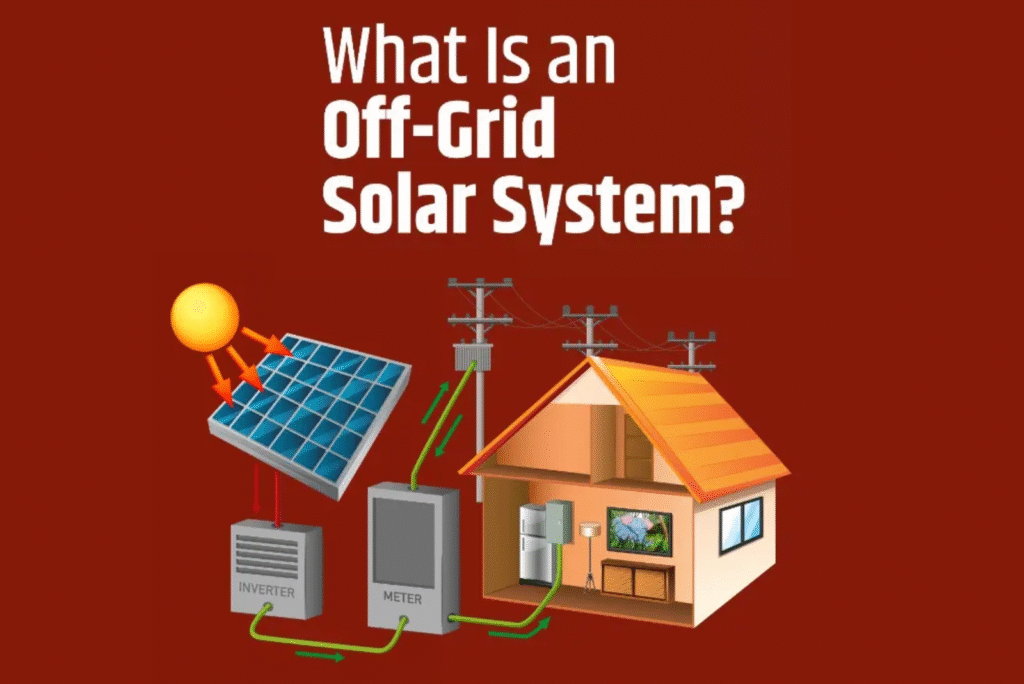
What Is an Off-Grid Solar System? Home Blogs Popular Posts All Posts Blog What Is an Off-Grid Solar… October 4, 2025 What are the Main Components… October 4, 2025 What is a Solar Street… October 3, 2025 What is a Solar Water… October 3, 2025 Power Your Future with KLK Ventures Pvt. Ltd. Delivering reliable solar solutions for a sustainable tomorrow. Switch to clean energy and save with us today. Contact US Sunlight by day becomes the electricity that keeps the night bright. No need to rely on outside energy sources, no high electricity costs, and no frequent power outages. An off-grid solar power system’s magic lies in that. An off-grid solar system is one that doesn’t require a connection to the local electricity grid. It works independently of the grid, hence the name. In this system, solar panels harness solar energy. Either households or appliances use the generated energy instantly or it goes to solar batteries for later use. The best part about off-grid solar power systems is the solar batteries they come with! These make the systems useful even when the sun is not shining. Are you curious about the amazing off-grid solar system and want to understand it better? Read on. How Does an Off-Grid Solar System Work? You may often wonder how an off-grid solar system works so efficiently. The magic happens with the help of the key parts of the off-grid solar power systems. Let’s learn how a solar power system makes the appliances run. 1. Solar Panels Solar panels or PV panels are the heart of an off-grid solar system because of their function. The amazing job of converting the warm sunlight into electricity is done by these panels by the means of the photovoltaic effect. The electricity that these solar panels produce is direct current electricity. Learn more in detail about the solar panel components and how photovoltaic panels create power. 2. Charge Controller Like all things in life need balance, similarly, an off-grid solar system needs it too. A charge controller makes sure of it. It controls the amount of solar energy that reaches the batteries. Incorrect charging can cause damage and low performance from your batteries. 3. Solar Batteries Off-grid solar power systems are only able to produce electricity when the sun is shining, as you are already aware. The panels won’t be able to receive sunlight to produce electricity after the sun goes down. Here’s where the concept of solar energy storage enters the picture. You can, in this way, power your house and appliances without relying on the main power grid and also during power cuts or bad weather. 4. Inverter The appliances in your home require alternating current (AC) to function. And because the off-grid solar power systems generate direct current (DC), your system won’t work without an off-grid solar inverter. The inverter converts the DC electricity into AC electricity. Let’s go through the process again: sunlight → solar panels → charge controller → batteries → inverter → appliances. Simple, right? Benefits of Off-Grid Solar Power Systems Are you thinking that saving electricity bills is the only thing an off-grid solar system does well? Well, you’re in for a surprise. Let’s go through all the benefits of off-grid solar power systems. ● Complete Energy Independence Relying on the local electricity grid can at times prove to be tiresome. Who wants to face unexpected power cuts and unreliability? No one! With an off-grid solar system, you’ll be free of such worries as you’ll be able to generate your own electricity. For people living in rural areas, this energy independence is a boon! ● Reduced Electricity Bills Your money will be saved with the installation of an off-grid solar system. The initial cost will be a bit high, but after that get ready to save your pocket. Off-grid solar power systems generate electricity using the sun as the main source. And the solar power is free of cost which makes the solar system cost-effective. The continuous use of off-grid solar systems will reduce electricity bills to a great extent. ● Sustainable and Eco-Friendly When it comes to development, the environment faces all the challenges. An off-grid solar system will lift your worries about the environment and the future. The minimal negative environmental impact is what makes these systems so popular. You already know that solar energy is a clean and green source and when people use solar power systems to harness the same energy, it benefits a lot. First, there’s a reduction in the reliance on fossil fuels, and second, these off-grid solar power systems contribute to a greener and sustainable future. ● Ideal for Remote Locations There are areas where proper grid connectivity hasn’t been reached yet. And laying down the whole electricity grid may not be a feasible option, such places can benefit from the off-grid solar power systems. The power will be supplied constantly with the help of solar energy. This method is not only eco-friendly but also wallet friendly! ● Low Maintenance, High Durability An off-grid solar system requires very minimal care. They do function pretty well but you’ll be surprised to know how low-maintenance they actually are. Most solar panels are designed to last up to 25 years, and batteries can last up to 10 years. With the necessary services, your off-grid solar power systems will keep running for years and prove to be a fruitful investment. ● Boost Property Value There are so many benefits of off-grid solar systems for homes. Whether you live in it or decide to sell it. Potential buyers are drawn to properties with solar panels because they are considered valuable and appealing. Everybody desires a house with small carbon emissions and low energy expenses. Therefore, installing an off-grid solar system can significantly increase the value of your home! Installation Process of an Off-Grid Solar System The installation process can be a bit complex when you compare it to setting up traditional home appliances. Let’s break it down for you. Step 1: Site
What are the Main Components of a Solar Panel?
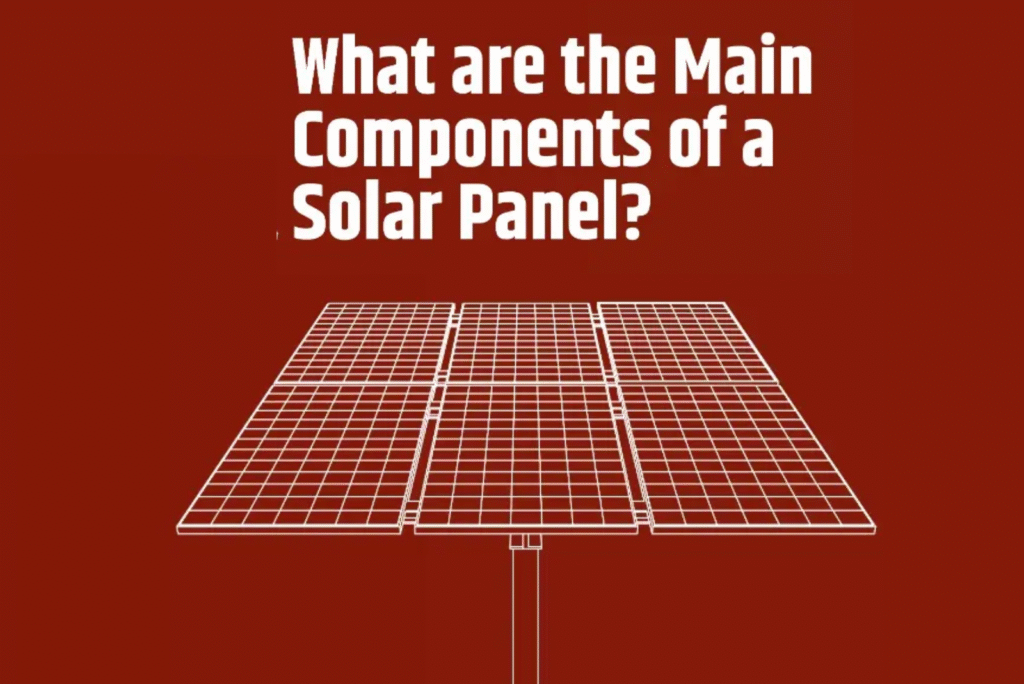
What are the Main Components of a Solar Panel? Home Blogs Popular Posts All Posts Blog What are the Main Components… October 4, 2025 What is a Solar Street… October 3, 2025 What is a Solar Water… October 3, 2025 Different Types of Solar Mounting… October 3, 2025 Power Your Future with KLK Ventures Pvt. Ltd. Delivering reliable solar solutions for a sustainable tomorrow. Switch to clean energy and save with us today. Contact US Have you ever wondered what makes a solar panel so amazingly efficient? Solar energy has been gaining popularity, but the magic happens inside a solar panel. The glossy surface of the solar panels has an intricate system of many components. These components of solar panel work together to harness the sun’s amazing energy. Understanding these components isn’t just for curious people, but also for people who are looking to invest in solar power systems. In this blog, we’ll break down the solar panel components and explore their importance. Main Components of a Solar PV Module Before we move on to the components of solar panel, we ought to clear up a common misconception. A solar PV module is made up of several solar cells that combine to produce electricity by means of the photovoltaic effect. And when the modules are linked together, they form a solar panel. Learn more here: Cells, Modules, Panels, and Arrays. 1. Solar Cells You can call solar cells the heart of the system. These cells are what allow a solar panel to function; they are composed of silicon, a semiconductor material. One of the main components of solar panel is solar photovoltaic cells. The electrons in the panel are excited by the sun’s rays and produce direct current electricity. There are two types of solar cells: Monocrystalline solar cells and Polycrystalline solar cells 2. Solar Glass The top layer and another important components of solar panel is glass. This transparent cover sitting on top of the solar cells offers protection. The fragile solar panels components need the protective shield of solar glass. It protects the solar cells against harsh weather while letting abundant sunlight reach them. The tempered glass’s main function is to maximize the light transmission and protect the photovoltaic cells. Solar glass is what helps increase a panel’s energy absorption. 3. EVA (Ethylene Vinyl Acetate) With all the protection they require, we can say solar cells are really fragile. Apart from the protective layer of solar glass, solar cells require EVA, one of the main components of solar panel. This encapsulation layer offers safety to the cells from dust and moisture while also binding the glass and solar cells together. It holds everything together and prevents the degradation of solar cells. All of this makes EVA one of the vital solar panel components. 4. Backsheet By now, you already know how high-functioning solar panels require protection. One of the important components of solar panel is the back sheet. It protects the solar cells and other components from environmental factors like dust, moisture, and UV radiation. It’s made of polyvinyl fluoride (PVF), a durable material. Do you know what would happen without a backsheet? Your solar panel will become weak and ultimately, dysfunctional! 5. Aluminium Frame You can call the frames a support system for the solar panels. The aluminium frame, one of the most important components of solar panel, supports the panels structurally and also helps maintain the efficiency of solar panels. These are a great help, along with different types of solar mounting structures. Because it resists corrosion, the aluminum frame is thought to be perfect for outdoor settings. The efficiency of the solar panel will drastically decrease in the absence of an aluminum frame. 6. Junction Box On the backside of the solar panels, you’ll find one of the best and crucial components of solar panel, the Junction Box! This box is where all the important wiring happens to ensure the flow of current to the inverter. The diodes inside the junction box prevent the reverse flow of current and enhance the efficiency of a solar panel system. This also reduces the potential risk of damage. 7. Interconnectors Some sites and businesses require large solar installations, and interconnectors are what help in such cases. Many solar modules need to be connected together in order to get maximum output. Small electrical connectors link these modules in a series, creating a network. Interconnectors are one of the most crucial components of solar panel. Because of them, solar panels produce electricity in large amounts. 8. Inverters Inverters are also considered the main components of solar panel due to their function. You already know solar panels generate direct current (DC) electricity, which most households can’t use. An inverter converts direct current into alternating current (AC). With the help of inverters, a solar panel becomes really useful for generating usable electricity. Other Components of a Solar Panel Include: ● Solar Battery – When solar panels aren’t working, a solar battery can be used to store extra electricity. ● Sealants – A substance applied to the edges of solar panels to keep them safe. It provides support and protection to the components. ● Anti-reflective Coating – This layer reduces light reflection and increases sunlight absorption. Helpful in maximising the energy output. Why Components of Solar Panel Matter By now, you’d have a clear picture of solar panel components and their function in your mind. Each part of a solar panel has different purposes, and when they come together, they form your amazing solar power system. All the elements used in a solar cell are responsible for the amazing function that solar cells offer. Solar cells convert sunlight into electricity. And the protective solar glass protects solar cells and other solar panel components. The quality of the components of solar panel is what matters a lot too. For example, a high-quality EVA layer protects the solar cells from moisture and dust accumulation. And a good frame supports the solar panels. These solar
What is a Solar Street Light?
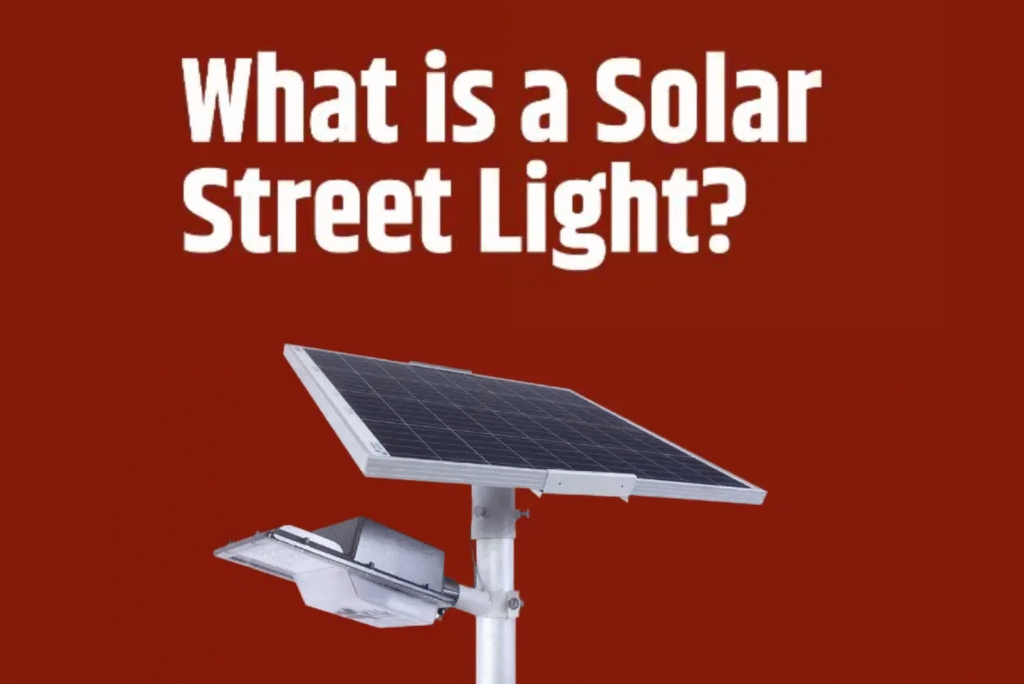
What is a Solar Street Light? Home Blogs Popular Posts All Posts Blog What is a Solar Street… October 3, 2025 What is a Solar Water… October 3, 2025 Different Types of Solar Mounting… October 3, 2025 Best Solar Company in Noida:… October 3, 2025 Power Your Future with KLK Ventures Pvt. Ltd. Delivering reliable solar solutions for a sustainable tomorrow. Switch to clean energy and save with us today. Contact US Street lights are essential for safety purposes, and one can witness the growing popularity of them. A solar street light takes this one step further with its reliance on solar panels for power rather than the regular grid electricity. The advancing technology has offered solar street lights as a sustainable, long-term solution. Solar street lights are different from traditional ones, offering many advantages. Thanks to the photovoltaic panels, which generate clean electricity, making these street lights efficient. In this blog, we’ll learn more about these wonderful solar street lights! Components of a Solar Street Light Component Description Solar Panel Converts sunlight into electricity. Battery Stores energy from the solar panels. LED Lamp Provides illumination with low energy consumption. Charge Controller Manages energy flow between the panels, battery, and light. Pole Supports the solar panel and light fixture. Lamp Post Protects the light fixture. Light Sensor Automatically turns the light on at dusk and off at dawn. Inverter Converts DC to AC for certain systems. How Does a Solar Street Light Work? You can easily understand the working of the solar street light by following a step-by-step approach. Understand with us in easy steps how these outdoor solar lighting systems operate. Step 1: Capturing Sunlight Photovoltaic panels are installed near or above the poles of these solar street lights. These panels collect the photons of the sunlight to make electricity out of it. Step 2: The Electron Movement When the rays of the sun meet with solar cells made of a semiconductor, the activated electrons start their to-and-fro movement. This flow contributes towards the generation of direct current electricity in the circuit. Step 3: Storage in a Rechargeable Battery Since these solar lights use the sun’s energy to generate electricity, it’s to be used instantly. But what happens when there’s no use for the electricity? For such times, batteries allow for the usage of electricity when the sun doesn’t shine. These batteries are charged with electricity. Step 4: Role of a Charge Controller Controllers act as intermediaries between the batteries and panels. They safeguard the battery life of the street lights by voltage regulation. They manage the amount of voltage and current coming from the panels. Step 5: Photoreceptors and Their Importance The street lights know when to turn on and off without manual assistance. How? Well, the photoreceptors or light sensors detect the lack of sunlight and wave a green flag to energy movement from batteries to LED bulbs. The reverse of this happens at every daybreak. What are the Advantages of Solar Street Lights Lighting Efficiency: We have just read that solar street lights use LED lights in most cases. They are used extensively because of their brighter and more energy-saving nature. Hence, making the solar lighting system more effective. Environment-Friendly: Our ultimate source of energy here is the sun. Needless to say, this sort of energy is less harmful to the environment and at the same time, renewable too. Large-scale use of solar street lamps negatively impacts our dependency on fossil fuels, which is a good thing! Cost-friendly: We can all agree upon the need for cost-friendly options for large-scale projects. Apart from the installation costs, the operation of these solar lamps requires minimal spending. Since they are self-sufficient in producing their energy, they only need proper maintenance at times. Return on Investment: The return is very positive in the case of solar street lights. They last for many years and function properly. Innovations make for excellent weather protection, further increasing their lives. Reliability: Solar options in general ensure freedom from the grid and its complications. So, our solar street lights are very reliable in situations of power cuts or faults. They will shine regardless and provide help at night. Accessibility: This is also directly linked to their independent nature. We cannot deny how important Solar lighting systems are. In areas where there is no grid power supply, we can install them instead. The comfort of light can reach even the remotest of places. Safety and Security: With remarkable efficiency and reliability, solar street lights are the king of all choices in this area. They will aid by increasing visibility, allowing access to travel and also reducing instances of crime. Well-lit communities and roads are indeed preferable to all of us! Applications of a Solar Street Light Residential Areas: Enhances safety and visibility, reducing crime and accidents at minimal cost. Parks & Public Spaces: Provides eco-friendly, reliable lighting for safe recreational areas. Parking Lots: Illuminates dark parking areas, ensuring security for workers and customers. Roads & Highways: Improves road safety with constant lighting, even during power outages or bad weather. Remote & Rural Areas: Offers a cost-effective and reliable lighting solution where traditional electricity is unavailable. Emergency Lighting: Acts as a backup during power disruptions, aiding rescue operations and ensuring safety. Installation Process of Solar Street Lights The installation process for solar street lights is really interesting and easy to grasp. Let’s look at it in detail below. 1. Prparing the Pre-requisites Before we even begin with the panels and batteries, prior work needs to be done. This will include selecting a suitable location for placing the poles. It’s followed by preparations for installing and fixing poles at all designated places. 2. Pre-assembly Work Now is the time to bring all our components before setting up the system. Check whether all the parts are functioning properly or not, so that later malfunctions can be avoided. 3. Battery and Panels Installation The next important step will, of course, be to add a battery and solar panels. Install panels in a manner that maximizes their exposure to sunlight for more energy
